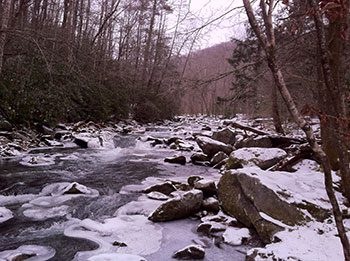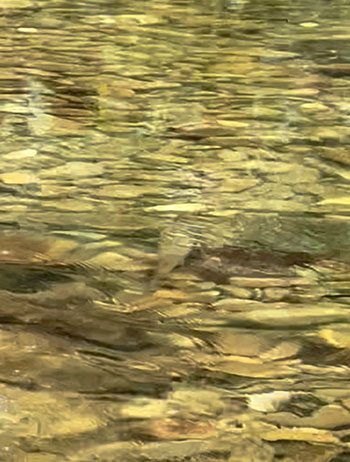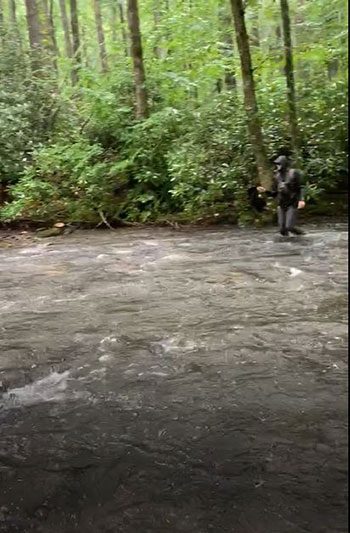By Jim Parks
So much interest is placed on the best flies to use and to have on hand when fishing for trout, as well it should. However, there is much more than simply considering what trout will bite. Just as important is to determine the how, where, and why. Most experienced anglers have enjoyed an epic day on a stretch of water, only to return later to struggle to get a strike. A huge influence on the success or failure of a day on the water is the water conditions. To be honest, there’s little we can do about it, so we tend to accept what we have and fish on. The exception, of course, is tailwaters where we can plan our arrival to coincide with the best time, based on the generation/release schedules. I’m probably in good company with those forced do the proverbial fifty yard sprint in waders to reach safety as a result of a sudden release of water worthy of a “Poseidon Adventure” remake! As a twelve year old, I was once trapped on an island with my youthful fishing buddies. Suffice to say, the ending included the local Rescue Squad! But that’s a different story for another time.
The hallmark of a great angler is the ability to adapt to the conditions, along with a gift for problem solving. Trout live in water and thus, water is a major factor for which we must know how to alter our approach, technique, and gear if we wish to succeed. The three major water conditions I consider in planning for a trip are, water temperature, water level, and water clarity – TLC’s. Following is a synopsis of how I approach each aspect.
Water Temperature:
Bottom line, trout are cold blooded. For the most part, the ideal temperature range for trout is 55 to 64 degrees. The colder the water, the lower their metabolism, which means the trout become hungry less often, but colder water carries more dissolved oxygen. High water temperatures can be one of the most lethal times for trout, as there is limited oxygen in the water, but they have a high metabolism. Think how you’d feel with an appetite but unable to breath. To make matters worse, warm, low water conditions where there’s little food can literally lead to trout starving to death.

Throughout the day, the water temperature changes, which can be good or bad depending on the starting point and direction of the change. Let’s say the water has been in the upper 30’s and the temperature rises, to 45. The change to a more preferred temperature range can turn the fish on. However the opposite is true, a sudden drop in water temp from 45 to 39 can turn off the bite. Similarly, a high temperature, say 65, suddenly drops into the more preferred temperature of 60 can mean it’s a great time to be out on the water. So, always consider not only the temperature but the direction in relation to the preferred temperature range. If the temperature is moving toward the preferred range, good things can happen.
As stewards of our resource, we should never fish during times of warm water where the trout are under stress. This can vary depending on the type of water and general location, but 67 degrees is where I generally draw the line in the freestone streams where I mostly fish for trout. As the water creeps upward above the low 60’s, trout will tend to move to “the bubbles”, at the foot of waterfalls or other locations where the water is more oxygenated than nearby locations. On the contrary, colder water tends to find trout lying in slower water, often at or near the bottom with a lower appetite.

Water Level:
Personally, low water levels make me sad. For me, low levels coupled with gin clear water, can make approaching the water without fish scattering, very difficult. Stealth is crucial and includes a slow approach and long, delicate casts. I much prefer slightly elevated water levels and flow. I guess I feel a bit more secure in my ability to get within casting range of where trout are feeding. Also, higher water levels tend to wash more food into the streams, inviting trout to dinner as well as provide a friendlier water temperature for the trout. During periods of higher water, trout will be found in “softer” areas adjacent to the current, in still water, behind a rock or log, or sometimes lying on the bottom with their eyes up for anything appealing drifting by. It is during these periods that weight is often necessary to get the fly down near the bottom to the trout.
Water Clarity:

Wild trout are naturally skittish, and lying in clear water makes them downright paranoid from underwater predators and those from above. Couple that with low levels and it seems not even a twitch is required to send them scurrying to their hiding spot. However, a heavy hatch will often bring them out into the open for a good buffet. This is the time for dries and long leaders. My absolute favorite time is when water is going from clear to dingy. Standing in the stream as visibility drops, I can imagine trout coming out of hiding as more food is washed into the water. The dingy water gives them a sense of protection where their desire to stay hidden lessens and they feel free to roam and look for a nice large meal such as beetle, nymphs washed along, or small fish. I’ve had opportunities to fish a stream below where a muddy tributary enters. From my experience, fishing the seam where muddy meets clear has been very productive water. Additionally, dingy water will allow the use of larger tippet sizes. For me, whereas I typically use 4x, I will go to 3x for a couple of reasons that allow me to land the fish quicker, thus reducing stress on the trout, and in the event I hook into a larger trout, I have more “leeway” in the force I can apply during the fight. The opposite is true for clear water, where I will decrease my tippet size, especially in water inhabited by wild or “educated” and leader-shy fish.
EXTREME care must be taken in muddy water, as in two creams in a cup of coffee muddy, as it can make wading not only difficult, but dangerous. Where I fish, there can be holes you can easily step in over your head! The availability of a collapsible wading staff is a HUGE help. Finally, if you wish to risk muddy water, one method to overcome the trout’s limited visibility is the use of some form of vibration to get a trout’s attention and possibly a strike.

Find your Combination: My ideal “hunting” conditions on small freestone streams, I mean those times where I get jittery with excitement because I know the “big boys” will come out to feed, are when the water temperature is between 58-64 degrees and clear, then a sudden cloudburst, as often happens in the Smoky Mountains, dumps heavy, frog-drowning rain. The water rises, gets murky, and I have either a streamer or two big, heavy nymphs on. I’ve caught the majority of my trophy trout in these exact conditions. Over the past several years, I’ve learned to watch for weather patterns and blending that with USGS stream level information, I have been successful in hitting the conditions on a semi-regular basis. I try to my hide smile when asked if I’m going fishing when heavy rain is in the forecast. Of course I am!
Takeaways:
Take a thermometer, and use it on the stream. Sometimes there is a feeder stream that has a more optimal temperature that you can fish or focus downstream of its entry. I’ve had magical moments in just a scenario. Also, alter your approach with a greater detail in stealth when the water is clear. Regardless of the clarity, be wary of your wake if you’re wading. Those are sound waves easily detected by fish. Remember the sun on bright days and be careful of your shadow on the water. Alter your tippet size based on water clarity and remember to focus on the appropriate section of water based on the water temperature and level.
As you plan your next trip or find yourself on the water, remember to apply a little “TLC”, temperature, level, and clarity, to the water in your decision-making. May you find the combination that gives you jitters of excitement for what is about to happen.
Jim Parks is a frequent contributor of Costal Angler Magazine. He has fished the Smoky Mountains forty-four years and has written the book Tails of the Smokies, which can be found on Amazon and in Kindle and iTunes formats. Instagram Page: TailsOfTheSmokies.